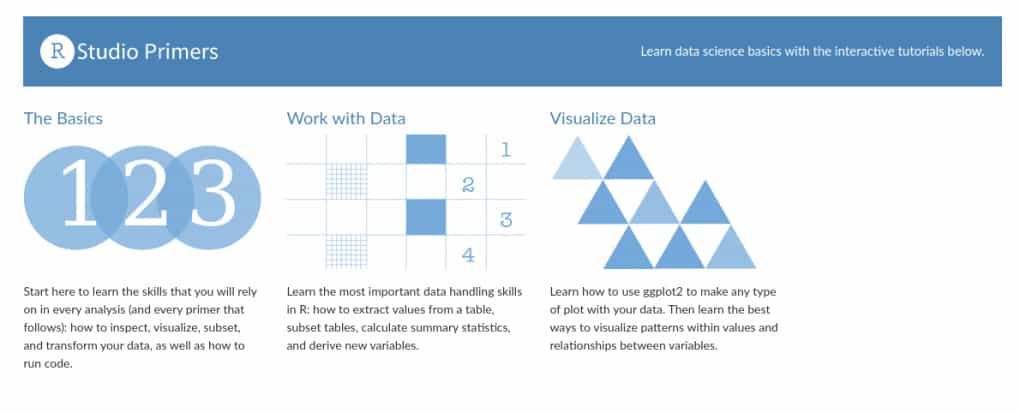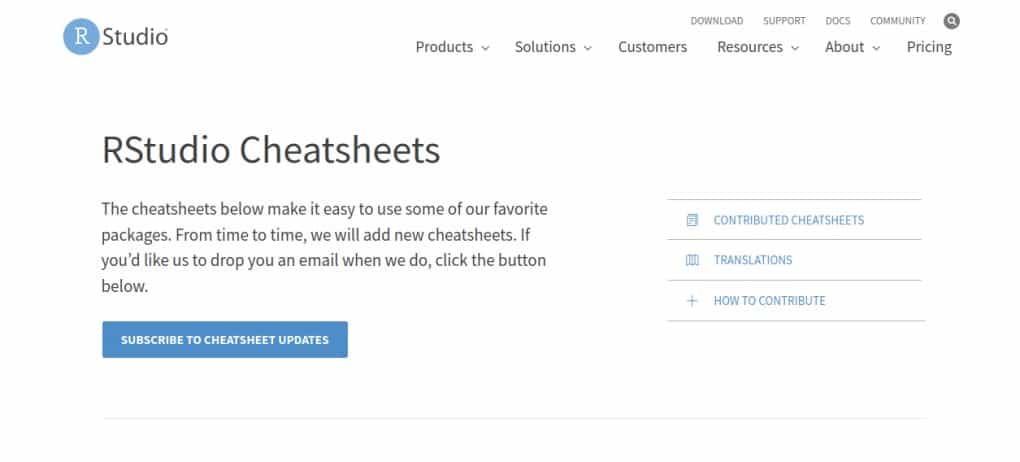
How to Learn R Programming: Top Learning Resources
The use of the R programming language is hard to avoid in data science. Either you will end up using R yourself or you will come across discussions about how to use R in the communities of which you are a part. R is a popular data science tool and this is no surprise. R is incredibly versatile, offering what data scientists need to effectively analyze a data set.
Finding learning resources for the R language can be difficult because there are many available online from which you can choose. So, we have decided to do some research and give you summaries of the best resources we found online for learning R. This guide covers three types of resources: books, courses, and tutorials.
What is R Programming?
R is a programming language for statistical computing and data analytics. The language is used by mathematicians, data analysts, and researchers to find insights in a dataset. You can clean, process, analyze, and chart data all in the R Programming language. R was first released in 1993 and since then has received regular updates.
The R language is supported by the CRAN (Comprehensive R Archive Network) community which has thousands of packages R developers can use in their work. These packages build upon the R language and make it easier to perform specific tasks, like building machine learning models or creating more intricate visualizations.
Why Should You Learn R Programming?
Choosing to learn any programming language requires a big commitment. You may be wondering to yourself why learning R is worth your time. Here are three reasons why you should consider learning the R programming language:
- R is an industry staple. Alongside Python, R is one of the most accepted programming languages used in data science today. This means that there are plenty of resources documenting how to use R effectively in a variety of use cases. R is used by companies like American Express, Google, Amazon Web Services, the BBC, and Dyson.
- R could help you find a job in the data field. According to Glassdoor, there are 30,760 jobs open in the United States for data scientists (as of March 10). While not all of these jobs will require R as a skill, R is an incredibly valuable (and often required) skill in the job market.
- R pays well. Glassdoor reports the average data scientist earns $113,309 per year. Not all of these positions will require R as a skill but R is a common skill in data science jobs. An entry-level salary will probably be lower than the one above but as you gain experience you will be positioned to earn excellent salaries.
- R is versatile. R is used in statistics, mathematical computing, machine learning, and data science. R is used for data cleaning, processing, analysis, and visualization. This shows there is plenty you can do with your R knowledge.
You will need to spend some time considering whether learning R is worth it for you. The above four reasons should give you a taste of why some people choose to learn R and help you decide whether you want to learn R programming.
The Best Books for Learning R Programming
Programming books are a common tool for learners, used by beginners, intermediate developers, and experts alike. What books are best for people who want to learn R? We did some research to help you answer this question.
Here are three top books that are worth looking at if you are looking for an R programming book to read.
’The Art of R Programming: A Tour of Statistical Software Design’ by Norman Matloff
This book teaches how to write programming in the R language. You will start off with the basics and then move onto gradually more complicated topics such as closures. This book teaches some functional and object-oriented principles, which are two paradigms supported by R.
This book is good whether you have already started learning R and want to learn more or if you are at the very start of your learning and need a place to begin.
‘Hands-On Programming with R’ by Garrett Grolemund
You will learn R with reference to real-world examples with this Hands-on Programming with R. This book was written for non-programmers so you do not need any programming experience to get started.
You will work on building skills like working with R objects, using packages, and building an environment. You will complete three main projects: a weighted dice application, a playing cards application, and a slot machine application.
‘R For Dummies’ by Andrie de Vries and Joris Meys
R for Dummies is part of the “for Dummies” series of books. This book, which has been updated to a second edition, talks about the essential topics you need to know in the R language. You do not need any coding experience to benefit from this book.
You will learn about topics like installing R, importing data into R, working with regression models, and splitting data. This book also discusses how to use R to create visualizations that represent your findings from a dataset.
The Best Courses for Learning R Programming
Online courses are a popular choice for learners. Online courses are good because there is usually an instructor who guides you through what you need to learn in a video format which means that you can visualize what you need to learn.
Here are three of the best courses for learning R programming.
Programming with R by Mihaela Danci

This course is divided into modules which cover topics like vectors and factors, arrays and lists, and getting started with R. Each module comes with short videos that introduce you to one concept at a time. This means that if you are ever confused about a topic, you will easily be able to find where you need to go to revise that topic.
You must have a Pluralsight membership to access this course, which costs $29 per month.
R Programming for Statistics and Data Science 2021 by 365 Careers

This course teaches the fundamentals of R programming. You will learn about functions, exploring data, importing and exporting data to and from R, creating graphics with ggplot2, and R. This course is ideal for beginners who are new to R or who have a bit of knowledge and want to learn more about R programming.
Alongside the video in this course, there are materials for you to read which will help you build your knowledge of R coding. This course costs $99.99 and comes with a 30-day money-back guarantee.
Data Science: Foundations using R Specialization by Johns Hopkins University

This data science course teaches how to use R in data science over the course of five modules, each of which lasts one week. You do not need any prior experience to take this course.
In this course, you will cover topics like using GitHub to manage your projects, setting up your programming environment, analyzing and visualizing data, cleaning data, and more. YOu will also complete a capstone project at the end of the course.
The Best Tutorials for Learning R Programming
Written or video tutorials may not cover as much ground as a course or a book but they often go into great depth about a topic that you may not otherwise see in other learning resources. A lot of learners prefer tutorials to improve their knowledge or learn the basics because they are more focused on a particular topic.
Here are a few tutorials we found that are suitable for beginners to R programming.
RStudio Primers by RStudio

The RStudio Primers are a good place to start learning how to work with R and the RStudio programming environment. The primers are interactive and come with quizzes, graphics, code snippets, and code outputs which will help you build your knowledge. The primers cover topics like iteration, visualizing data, writing functions, inspecting data, and more.
RStudio Cheatsheets by RStudio

Are you struggling to remember a particular concept? Or do you want to revise a particular topic you have already learned about. If the answer to either of these questions is “yes,” then this website is worth a look. The RStudio Cheatsheets cover topics like factors with forcats, working with dates and times, and using strings.
My 3 video presentations on “Essential R” by Tinniam V Ganesh
Tinniam V Ganesh has written extensively on data science, deep learning, and cloud computing. Tinniam has also recorded three videos on essential R topics. These videos cover how to create an R package, how to work with essential R packages like ggplot2, and the fundamentals of working with R.
Once you have viewed these videos, you should check out Tinniam’s blog where he has written dozens of tutorials on R programming.
Conclusion
The R programming language is one of the main tools that data analysts and scientists use on a regular basis. R can be used to clean, analyze, and visualize datasets. R comes with a range of packages which extend the language. Thanks to these packages, you can do things like build machine learning algorithms and create more advanced graphics from your date.
The books, courses, and tutorials that we have discussed should help you get started on your journey toward learning R. We recommend you take a look at each resource and do more research into the resources that interest you the most. The right learning resources will make it a lot easier for you to learn R so spending time looking at what’s out there is a good idea.

